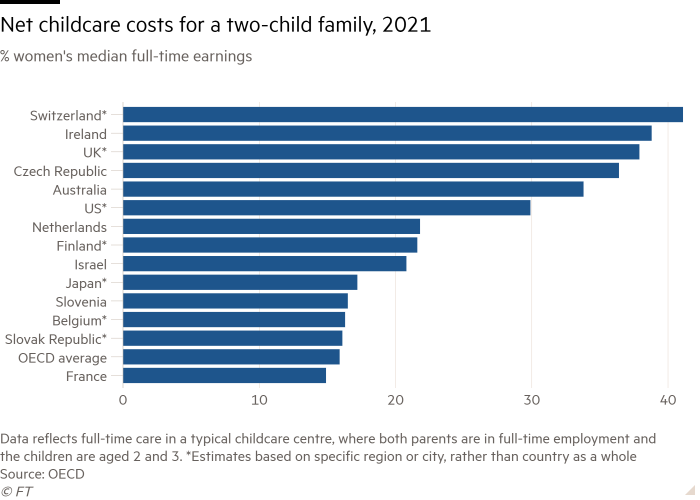FT reader survey: Childcare subsidies will help women return to the workplace

Roula Khalaf, Editor of the FT, selects her favourite stories in this weekly newsletter.
Sarah’s entire monthly salary went on paying for nursery fees for her son when he was young and yet it still wasn’t enough to cover the costs in full — the rest had to come out of her husband’s wages. Now her child is at school her childcare costs have come down, but she says more needs to be done to support mothers returning to the workforce.
“It seems that only the wealthiest people — those who can easily afford childcare — are able to have more than one child and go back to work full-time,” the England-based healthcare worker in her forties told the Financial Times.
It seems she is far from alone in this view. A global survey of FT readers heard from many parents around the world about the difficulties of juggling career and childcare. The survey, carried out in the first half of September, gathered more than 100 responses from people on how to improve childcare provision.
Calls for policymakers and governments to help with childcare costs topped the survey, with the majority of people citing greater subsidies for childcare provisions as the answer to encouraging more women, in particular, back into the workplace.
While the majority of respondents to the survey were based in the UK and US, others shared their views from Europe, Taiwan, Argentina and Brazil. Many did not want to share their full names or personal details for fear of professional repercussions.
For Angela, a legal counsel in Baltimore in the US, and a single mother, the only option after the birth of her triplets was to move back in with her parents.
“I had to make significant life changes. I moved from NYC back in with family in another state so that I could have the help needed to make it work. I knew I would not be able to manage both full-time work and childcare without this help,” she said.
“I am a hard-working professional and there is no reason I should not be able to afford my family. I suspect a man in my situation would be able to do so but I didn’t earn enough. We absolutely need to reform our system to a model that works, such as that adopted by Denmark.” Danes pay up to roughly 30 per cent of the cost of childcare, with those on low incomes or single parents able to pay less than that. The government makes up the difference.
More stories from this report
Female-led social enterprise tackles dysfunctional childcare system
Corporate abortion policies further complicate choices for female staff
A push for greater representation in the climate debate
How did your early work experiences shape your career?
Clare Smyth: ‘Pandemic teaches you how adaptable you are’
Carol, not her real name, is in her thirties and works in London as a finance director. She relies heavily on nursery provision for her two children and believes childcare should be funded by the government.
“I pay a vast sum of money every month towards childcare and it’s not sustainable. The government needs to subsidise childcare for working parents. It invests a fraction of what other countries invest as a percentage of our GDP,” she said. She added that her colleagues in Sweden pay just €100 a month per child for nursery.
“The comparison is insane when you look at what we pay here — more than 10 times this amount,” she said. “Without the funding from the government it is impossible for people [usually women] to work.”
Carol and others recommended that childcare costs be made tax deductible. “This would immediately alleviate the costs on families, without reducing direct funding to childcare settings,” she said. “It is also very straightforward to implement.”
The UK has some of the highest childcare costs in the world. According to data from the OECD, the Paris-based club of mostly wealthy nations, only Switzerland and Ireland are more expensive. It found that average costs across all the member countries, for a middle-income, two-earner couple, amount to 16 per cent of a woman’s median full-time earnings. The UK tops these countries with nearly 38 per cent of a woman’s earnings being spent on childcare.

Some working parents cited flexible working for helping people return to work, as it can wrap around school drop-offs and pick-ups. But others warned that this will create a bigger divide between those present in the office and those at home.
Katrina, who works within the education sector in the south-east of England, said hybrid working and the ability to work from home has helped her, but only slightly. She worries that “it will negatively impact on our careers (especially women taking advantage of this flexibility will likely be seen more critically in the future)”.
Others voiced concern about the impact of flexible working on people’s work-life balance. Michael, a man in his forties, who works in professional services in Chicago in the US, made the point that although hybrid working can help with childcare issues, it is also bad for employees’ mental health.
“It’s more challenging as the day is much longer since kids are home and not allowing you to focus on work. We are now working until past midnight each night,” he explained.
The father of three, who is paying roughly $25,000 a year for childcare, says things have got worse since the onset of the pandemic as childcare has still not returned to normal hours, and he and his wife spend much less time working and more time parenting. “It’s brutal and the pandemic has only made things more difficult.”
Respondents suggested employers could help working parents with emergency childcare should a sudden, unexpected need arise, as well as on- and off-site summer camps — or partnering with third parties to make it easier for parents to find these resources themselves.
But while these things are all nice to have, the majority of respondents agreed that whether or not women return to the workplace will come down to affordability. “Women will not be equals in the workplace until the economics of childcare are worked out,” said Sarah.
Women at the Top Americas Summit
Join leaders from Qualcomm Incorporated, PepsiCo, Twitter and more at our Women at the Top Americas Summit. Taking place on November 14 at the Dream Downtown, New York, as well as online, our speakers will discuss how purposeful action from leaders can drive real change. Claim our limited 25% discount offer on our VIP in-person summit using promo code SPECIALREPORT22. Register for your in-person or digital pass today.
Comments